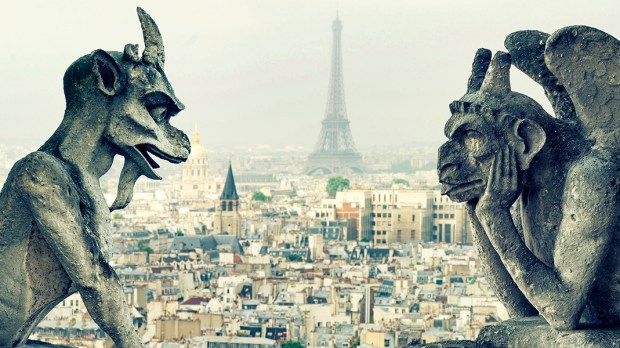A gargoyle is simply the protruding part of a pipe that serves to deflect water that would otherwise accumulate on a roof. It is by no means a medieval invention: Egyptians, Greeks and Romans used them in ancient times, in order to prevent moisture from destroying their ceilings.
In fact, the French word gargouille is a derivative of the verb gargouiller, which in turn derives from the Greek gargarizó: to gargle. That is precisely what, as an architectural element, the gargoyle is in charge of: a gargoyle collects and then expels water away from the roofs and walls of the building. Technically speaking, the fantastic stone carvings that do not serve as functioning downspouts are known as grotesques, not gargoyles, though popular imagination lumps them together.
The celebrated historian and art critic Jurgis Baltrusaitis, one of the founders of the school of comparative artistic research and author of the book The Fantastic Middle Ages, is a constantly cited authority when it comes to the study of the presence of the monstrous in medieval art. Baltrusaitis explained that the half-human and half-animal creatures of antiquity never disappeared completely in Europe. The presence of the gargoyles, then, could be explained as a survival of these Greek and Roman motifs in later European art.
Other sources attribute the use of gargoyles to a legend linked to the life of St. Roman, bishop of Rouen. According to legend, St. Roman managed to subdue a dragon – named Gargouille, “throat”– by merely showing him the cross. The Saint then tied a rope around the dragon’s neck and led him to the center of the city, where the dragon was killed and burned. However, the head and neck of the beast could not be consumed by the flames. Thus, St. Roman decided to hang it from one of the walls of the cathedral, as a warning: evil stalks, and can only be overcome by the cross.
Of course, this is but a legend. Some other historians point out that the use of gargoyles and grotesques in cathedrals also has a pedagogical function: the fantastic beasts reinforce the notion that evil remains outside the church, metaphorically and literally, and that evil flees from the holy places: “Upon this rock I will build my church, and all the powers of hell will not conquer it.” It was a way to graphically represent what is written in Scripture, in times when there were few who could read and write.

